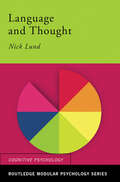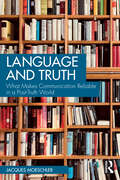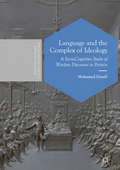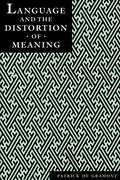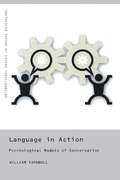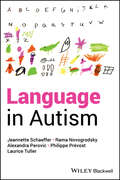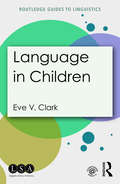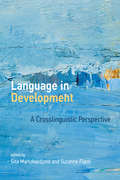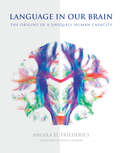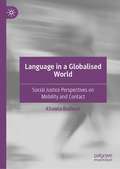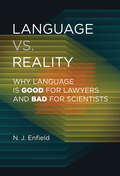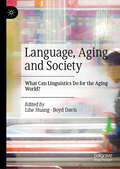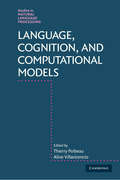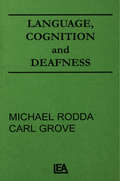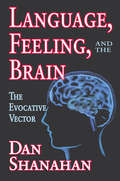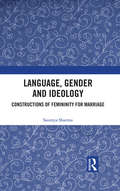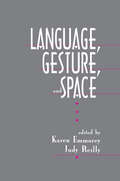- Table View
- List View
Language and Thought (Routledge Modular Psychology)
by Nick LundThis book fulfils the need for a clear overview of this area of cognitive psychology which encompasses both language and thought. Focusing on goal directed thinking and decision making, Nick Lund looks at the relationship between our grasp of language and our problem solving abilities. Different positions on the issues are contextualised and discussed in a way suitable for the AQA-A A-Level syllabus. Supplementary detail means that the book will also be valuable to other A-Level specification candidates and undergraduates coming to this area for the first time.
Language and Time
by Vyvyan EvansOne of the most enigmatic aspects of experience concerns time. Since pre-Socratic times scholars have speculated about the nature of time, asking questions such as: What is time? Where does it come from? Where does it go? The central proposal of "The Structure of Time" is that time, at base, constitutes a phenomenologically real experience. Drawing on findings in psychology, neuroscience, and utilising the perspective of cognitive linguistics, this work argues that our experience of time may ultimately derive from perceptual processes, which in turn enable us to perceive events. As such, temporal experience is a pre-requisite for abilities such as event perception and comparison, rather than an abstraction based on such phenomena. The book represents an examination of the nature of temporal cognition, with two foci: (i) an investigation into (pre-conceptual) temporal experience, and (ii) an analysis of temporal structure at the conceptual level (which derives from temporal experience).
Language and Truth: What Makes Communication Reliable in a Post-Truth World
by Jacques MoeschlerThe nature of truth is a current preoccupation both in political and social debates. The emergence and consequences of fake news and misinformation are at the core of what some call a post-truth world.Divided into two parts, Language and Truth develops the theoretical framework of language, truth, and communication. The book illustrates the way in which fake news is adhered to or rejected using case studies taken from political discourse such as the recent use of the word’s “genocide” and “denazification” by Vladimir Putin. It explores sources of information such as gossip and the everyday as well as exceptional uses of language such as humour.This is vital reading for scholars, researchers, and students of pragmatics, semantics, philosophy of language, cognitive psychology, sociolinguistics, language and communication, and language and politics within linguistics, psychology, and communication studies.
Language and the Complex of Ideology: A Socio-Cognitive Study of Warfare Discourse in Britain (Postdisciplinary Studies in Discourse)
by Mohamed DouifiThis book undertakes a systematic analysis of the workings of ideology in discourse, using an interdisciplinary approach that links language, cognition and society. Through examination of two corpora - a collection of British newspaper articles and a set of political speeches - the author examines Britain's involvement in the Iraq War (2003), and critically assesses the language practices which constructed a pro-war ideology under Tony Blair's premiership. Drawing on a constellation of concepts from van Dijk's socio-cognitive model, this book carries out both qualitative and quantitative analyses and conceptualises discourse as a nonlinear, highly discursive and socio-cognitive phenomenon. This innovative work will appeal to students and scholars of Cognitive Linguistics, Quantitative Linguistics, Social Constructivism, Critical Discourse Analysis, Political Sciences and Communication Studies.
Language and the Distortion of Meaning
by Patrick DegramontPatrick de Gramont draws upon evidence from infant observaton and linguistics as well as from information theory in order to make two related points. First, he demonstrates how our prevailing theories of meaning have failed to account for how we distort meaning.
Language at the Speed of Sight: How We Read, Why So Many Can't, And What Can Be Done About It
by Mark SeidenbergAccording to a leading cognitive scientist, we've been teaching reading wrong. The latest science reveals how we can do it right. <p><p>In 2011, when an international survey reported that students in Shanghai dramatically outperformed American students in reading, math, and science, President Obama declared it a "Sputnik moment": a wake-up call about the dismal state of American education. Little has changed, however, since then: over half of our children still read at a basic level and few become highly proficient. <p><p> Many American children and adults are not functionally literate, with serious consequences. Poor readers are more likely to drop out of the educational system and as adults are unable to fully participate in the workforce, adequately manage their own health care, or advance their children's education. <p><p>In Language at the Speed of Sight, internationally renowned cognitive scientist Mark Seidenberg reveals the underexplored science of reading, which spans cognitive science, neurobiology, and linguistics. As Seidenberg shows, the disconnect between science and education is a major factor in America's chronic underachievement. <p><p>How we teach reading places many children at risk of failure, discriminates against poorer kids, and discourages even those who could have become more successful readers. Children aren't taught basic print skills because educators cling to the disproved theory that good readers guess the words in texts, a strategy that encourages skimming instead of close reading. <p><p>Interventions for children with reading disabilities are delayed because parents are mistakenly told their kids will catch up if they work harder. Learning to read is more difficult for children who speak a minority dialect in the home, but that is not reflected in classroom practices. By building on science's insights, we can improve how our children read, and take real steps toward solving the inequality that illiteracy breeds. <p><p>Both an expert look at our relationship with the written word and a rousing call to action, Language at the Speed of Sight is essential for parents, educators, policy makers, and all others who want to understand why so many fail to read, and how to change that.
Language in Action: Psychological Models of Conversation (International Series in Social Psychology)
by William TurnbullFace-to-face conversation between two or more people is a universal form, and perhaps the basic form, of social interaction. It is the primary site of social interaction in all cultures and the place where social and cultural meaning takes shape. Face-to-face conversation between children and parents can also be an important context for social and cognitive development. Given the universality, frequency and importance of conversation in social life, a psychological model of conversation is required for an understanding of the central issues in social and developmental psychology. This book provides such a model.Language in Action presents a critical examination of four models of conversation: the Code model based on Chomsky's linguistic views; the Speech Act model of Austin and Searle; the Inferential model of Grice, and the Conversation Analytic model of Sacks and Schegloff. It also considers the Brown and Levinson model of politeness in conversation. Using many examples from natural talk and drawing on the positive aspects of the reviewed models, Turnbull proposes a new Social Pragmatic model of conversation as social interaction. He also describes the research paradigm of Social Pragmatics that experimental psychologists can use to study conversation. This book will be invaluable for advanced students in psychology, sociology, language and linguistics and communication. It will also make fascinating and lively reading for anyone wanting a greater understanding of this fundamental form of social interaction.
Language in Autism
by Jeannette Schaeffer Rama Novogrodsky Alexandra Perovic Philippe Prévost Laurice TullerA comprehensive exploration of language development and impairments in Autism Language is a critical yet understudied component of profiles across the autism spectrum. Language in Autism is a novel, interdisciplinary textbook that addresses this gap by consolidatingcutting-edge linguistic research and evidence-based insights into a single volume accessible to students, teachers, and professionals from a wide variety of disciplines. Authored by a team of leading experts affiliated with the Language Abilities in Children with Autism (LACA) network, Language in Autism applies what we know about the nature of human languageto the study of language in autism. With 16 finely crafted chapters, the textbook examines a broad range of issues central to language in autism. These include systematic examination of the different language components (the lexicon, phonology, pragmatics, etc.) as well as an array of topics that cut across these components, such as multilingualism, reading, or language in autism compared to other neurodevelopmental disorders. Designed with students and professionals in mind, Language in Autism incorporates practical tools such as explanatory text boxes, illustrations and structured chapter layouts to enhance comprehension and foster discussion. Each chapter includes foundational knowledge, real-world study examples, and forward-looking perspectives to inspire future research and intervention strategies. Equipping readers with the knowledge to make evidence-based decisions in clinical, educational, and research settings, Language in Autism: Features insights from the Language Abilities in Children with Autism (LACA) network, presenting the latest findings from psycholinguistics and clinical linguistics Follows a consistent and reader-friendly layout, with chapters organized into sections including 'Anchoring', and 'Focus on a Specific Study' Integrates pedagogical tools such as 'What Do You Think?' and 'What Do You Know Now?', to engage readers in critical thinking and self-assessment and encourage them to pursue deeper understanding of each topic Provides clear explanations of technical terms and acronyms, supported by accessible summaries and examples to enhance understanding Includes discussions on emerging directions in language assessment for autistic individuals Raises clearly and coherently the challenging issues raised by current views of autism and language in autism Language in Autism is ideal for undergraduate and graduate students in psycholinguistics, language acquisition, clinical linguistics, education, and speech-language pathology, as well as for medical students and interns. It is also a valuable reference for speech-language pathologists, teachers, physicians, linguists, clinical researchers, and other professionals working with autistic individuals.
Language in Children (Routledge Guides to Linguistics)
by Eve V. ClarkLanguage in Children provides a concise and basic introduction for students studying child language acquisition for the first time. Starting from the first sounds a child produces, this book covers all the stages a child goes through in acquiring a language. This title: Illustrates developmental stages from the recognition of sounds and words to the ability to hold a conversation, also covering bilingual upbringing and language disorders; Features real-life examples of all the phenomena discussed, from languages such as French, Spanish and Portuguese as well as English; Incorporates guidance on sources for further reading and exploration by chapter; Is supported by a companion website that includes exercises with links to real-world data in the CHILDES archive. Written by an experienced author and teacher, Language in Children is essential reading for students studying this topic.
Language in Development: A Crosslinguistic Perspective
by Edited by Gita Martohardjono and Suzanne FlynnExplorations of language development in different types of learner populations and across various languages.This volume examines language development in different types of learner populations and across various languages. The contributors analyze experimental studies of child and adult language acquisition, heritage language development, bilingualism, and language disorders. They consider theoretical and methodological issues; language development in children, discussing topics that range from gestures to errors in person and number agreement; and development and attrition of (morpho)syntactic constructions in second language learners, bilinguals, and Alzheimer's patients. The approach is "crosslinguistic" in three senses of the word: the contributors offer analyses of acquisition phenomena in different languages; they consider "crosslinguistic influence," or the potential effects of multiple languages on one another in the mind of the same speaker; and (in a novel use of the term, proposed by the editors) the chapters bring together theoretical and methodological approaches pertinent to the linguistics of language development in children, adults, and heritage speakers.
Language in Our Brain: The Origins of a Uniquely Human Capacity (The\mit Press Ser.)
by Angela D. FriedericiA comprehensive account of the neurobiological basis of language, arguing that species-specific brain differences may be at the root of the human capacity for language.Language makes us human. It is an intrinsic part of us, although we seldom think about it. Language is also an extremely complex entity with subcomponents responsible for its phonological, syntactic, and semantic aspects. In this landmark work, Angela Friederici offers a comprehensive account of these subcomponents and how they are integrated. Tracing the neurobiological basis of language across brain regions in humans and other primate species, she argues that species-specific brain differences may be at the root of the human capacity for language.Friederici shows which brain regions support the different language processes and, more important, how these brain regions are connected structurally and functionally to make language processes that take place in milliseconds possible. She finds that one particular brain structure (a white matter dorsal tract), connecting syntax-relevant brain regions, is present only in the mature human brain and only weakly present in other primate brains. Is this the “missing link” that explains humans' capacity for language?Friederici describes the basic language functions and their brain basis; the language networks connecting different language-related brain regions; the brain basis of language acquisition during early childhood and when learning a second language, proposing a neurocognitive model of the ontogeny of language; and the evolution of language and underlying neural constraints. She finds that it is the information exchange between the relevant brain regions, supported by the white matter tract, that is the crucial factor in both language development and evolution.
Language in a Globalised World: Social Justice Perspectives on Mobility and Contact
by Khawla BadwanThis book takes a critical look at the role of language in an increasingly diversified and globalised world, using the new framework of 'sociolinguistics of globalisation' to draw together research from human geography, sociolinguistics, and intercultural communication. It argues that globalisation has resulted in a destabilisation of social and linguistic norms, and presents a ‘language-in-motion’ approach which addresses the inequalities and new social divisions brought by the unprecedented levels of population mobility. This book looks at language on the individual, national and transnational level, and it will be of interest to readers with backgrounds in history, politics, human geography, sociolinguistics and minority languages.
Language in the Law
by John Carey V. Prakasam John Gibbons K. V. TirumaleshThe Language in the Law records the different modes and practices in the use of language related to law. The nexus between language and the law in various countries and cultures is examined in this book.
Language vs. Reality: Why Language Is Good for Lawyers and Bad for Scientists
by N.J. EnfieldA fascinating examination of how we are both played by language and made by language: the science underlying the bugs and features of humankind&’s greatest invention.Language is said to be humankind&’s greatest accomplishment. But what is language actually good for? It performs poorly at representing reality. It is a constant source of distraction, misdirection, and overshadowing. In fact, N. J. Enfield notes, language is far better at persuasion than it is at objectively capturing the facts of experience. Language cannot create or change physical reality, but it can do the next best thing: reframe and invert our view of the world. In Language vs. Reality, Enfield explains why language is bad for scientists (who are bound by reality) but good for lawyers (who want to win their cases), why it can be dangerous when it falls into the wrong hands, and why it deserves our deepest respect. Enfield offers a lively exploration of the science underlying the bugs and features of language. He examines the tenuous relationship between language and reality; details the array of effects language has on our memory, attention, and reasoning; and describes how these varied effects power narratives and storytelling as well as political spin and conspiracy theories. Why should we care what language is good for? Enfield, who has spent twenty years at the cutting edge of language research, argues that understanding how language works is crucial to tackling our most pressing challenges, including human cognitive bias, media spin, the &“post-truth&” problem, persuasion, the role of words in our thinking, and much more.
Language, Aging and Society: What Can Linguistics Do for the Aging World?
by Lihe Huang Boyd DavisThis book explores how studies of language and aging can be applied to build an aging-friendly society, drawing on the socio-pragmatic turn in language and aging to examine the perspectives of older adults experiencing aging through a linguistic lens. Research on the phenomenon and mechanisms of language in aging can provide older adults with language training, increase their active aging, and offer improved information communication channels for an aging society, which will bring a series of clinical and social benefits to handle problems in aging and language across the world. This book will be of interest to researchers in linguistics, sociology, gerontology and related fields.
Language, Biology and Cognition: A Critical Perspective
by Prakash MondalThis book examines the relationship between human language and biology in order to determine whether the biological foundations of language can offer deep insights into the nature and form of language and linguistic cognition. Challenging the assumption in biolinguistics and neurolinguistics that natural language and linguistic cognition can be reconciled with neurobiology, the author argues that reducing representation to cognitive systems and cognitive systems to neural populations is reductive, leading to inferences about the cognitive basis of linguistic performance based on assuming (false) dependencies. Instead, he finds that biological implementations of cognitive rather than the biological structures themselves, are the driver behind linguistic structures. In particular, this book argues that the biological roots of language are useful only for an understanding of the emergence of linguistic capacity as a whole, but ultimately irrelevant to understanding the character of language. Offering an antidote to the current thinking embracing ‘biologism’ in linguistic sciences, it will be of interest to readers in linguistics, the cognitive and brain sciences, and the points at which these disciplines converge with the computer sciences.
Language, Cognition, and Computational Models (Studies in Natural Language Processing)
by Aline Villavicencio Thierry PoibeauHow do infants learn a language? Why and how do languages evolve? How do we understand a sentence? This book explores these questions using recent computational models that shed new light on issues related to language and cognition. The chapters in this collection propose original analyses of specific problems and develop computational models that have been tested and evaluated on real data. Featuring contributions from a diverse group of experts, this interdisciplinary book bridges the gap between natural language processing and cognitive sciences. It is divided into three sections, focusing respectively on models of neural and cognitive processing, data driven methods, and social issues in language evolution. This book will be useful to any researcher and advanced student interested in the analysis of the links between the brain and the language faculty.
Language, Cognition, and Deafness
by Michael Rodda Carl GroveFirst published in 1987. Routledge is an imprint of Taylor & Francis, an informa company.
Language, Cognition, and the Brain: Insights From Sign Language Research
by Karen EmmoreyOnce signed languages are recognized as natural human languages, a world of exploration opens up. Signed languages provide a powerful tool for investigating the nature of human language and language processing, the relation between cognition and language, and the neural organization of language. The value of sign languages lies in their modality. Specifically, for perception, signed languages depend upon high-level vision and motion processing systems, and for production, they require the integration of motor systems involving the hands and face. These facts raise many questions: What impact does this different biological base have for grammatical systems? For online language processing? For the acquisition of language? How does it affect nonlinguistic cognitive structures and processing? Are the same neural systems involved? These are some of the questions that this book aims at addressing. The answers provide insight into what constrains grammatical form, language processing, linguistic working memory, and hemispheric specialization for language. The study of signed languages allows researchers to address questions about the nature of linguistic and cognitive systems that otherwise could not be easily addressed.
Language, Consciousness, Culture: Essays on Mental Structure (Jean Nicod Lectures)
by Ray S. JackendoffAn integrative approach to human cognition that encompasses the domains of language, consciousness, action, social cognition, and theory of mind that will foster cross-disciplinary conversation among linguists, philosophers, psycholinguists, neuroscientists, cognitive anthropologists, and evolutionary psychologists.Ray Jackendoff's Language, Consciousness, Culture represents a breakthrough in developing an integrated theory of human cognition. It will be of interest to a broad spectrum of cognitive scientists, including linguists, philosophers, psycholinguists, neuroscientists, cognitive anthropologists, and evolutionary psychologists.Jackendoff argues that linguistics has become isolated from the other cognitive sciences at least partly because of the syntax-based architecture assumed by mainstream generative grammar. He proposes an alternative parallel architecture for the language faculty that permits a greater internal integration of the components of language and connects far more naturally to such larger issues in cognitive neuroscience as language processing, the connection of language to vision, and the evolution of language.Extending this approach beyond the language capacity, Jackendoff proposes sharper criteria for a satisfactory theory of consciousness, examines the structure of complex everyday actions, and investigates the concepts involved in an individual's grasp of society and culture. Each of these domains is used to reflect back on the question of what is unique about human language and what follows from more general properties of the mind.Language, Consciousness, Culture extends Jackendoff's pioneering theory of conceptual semantics to two of the most important domains of human thought: social cognition and theory of mind. Jackendoff's formal framework allows him to draw new connections among a large variety of literatures and to uncover new distinctions and generalizations not previously recognized. The breadth of the approach will foster cross-disciplinary conversation; the vision is to develop a richer understanding of human nature.
Language, Culture, and the Embodied Mind: A Developmental Model of Linguaculture Learning
by Joseph ShaulesThere is an odd contradiction at the heart of language and culture learning: Language and culture are, so to speak, two sides of a single coin—language reflects the thinking, values and worldview of its speakers. Despite this, there is a persistent split between language and culture in the classroom. Foreign language pedagogy is often conceptualized in terms of gaining knowledge and practicing skills, while cultural learning goals are often conceptualized in abstract terms, such as awareness or criticality.This book helps resolve this dilemma. Informed by brain and mind sciences, its core message is that language and culture learning can both be seen as a single, interrelated process—the embodiment of dynamic systems of meaning into the intuitive mind. This deep learning process is detailed in the form of the Developmental Model of Linguaculture Learning (DMLL). Grounded in dynamic skill theory, the DMLL describes four developmental levels of language and culture learning, which represents a subtle, yet important shift in language and culture pedagogy. Rather than asking how to add culture into language education, we should be seeking ways to make language and culture learning deeper—more integrated, embodied, experiential and transformational. This book provides a theoretical approach, including practical examples, for doing so.
Language, Dementia and Meaning Making: Navigating Challenges of Cognition and Face in Everyday Life
by Heidi E. HamiltonThis book investigates the ways in which context shapes how cognitive challenges and strengths are navigated and how these actions impact the self-esteem of individuals with dementia and their conversational partners. The author examines both the language used and face maintenance in everyday social interaction through the lens of epistemic discourse analysis. In doing so, this work reveals how changes in cognition may impact the faces of these individuals, leading some to feel ashamed, anxious, or angry, others to feel patronized, infantilized, or overly dependent, and still others to feel threatened in both ways. It further examines how discursive choices made by healthy interactional partners can minimize or exacerbate these feelings. This path-breaking work will provide important insights for students and scholars of sociolinguistics, applied linguistics, medical anthropology, and health communication.
Language, Feeling, and the Brain: The Evocative Vector
by Daniel ShanahanLinguistic theory since the Cognitive Revolution has fol- lowed one of the premises of that revolution by largely sidelining the issue of emotions and concentrating on those aspects of language that are more strictly cognitive. However, during the last ten years research in cognitive science, especially in neuropsychology, has begun to fill in the gaps left by the exclusion of emotions from cognitive research. The work of those like Oatley, Zajonc, Damasio, and LeDoux, to name a few, has demonstrated both that it is possible to construct models of how emotions play into the workings of the psyche and that they are necessary in giving us a balanced view of the human mind. Language, Feeling, and the Brain attempts to apply the fruits of this new research in emotion to our understanding of language itself. Building on Karl Pribram's integrated model of emotions and motivations, the book takes an eclectic approach to explaining how emotions contribute to the nature of language, drawing on research done in neuropsychology, philosophy, cognitive linguistics, anthropology, and related fields. Its aim is to construct a propositional model for how the emotions may have contributed to the emergence of symbolic formation, most especially in the forms of gesture and speech, and how identifying that emotional influence sheds new light on everything we have had to say about language itself, from lexis and grammar to culture and literature.
Language, Gender and Ideology: Constructions of Femininity for Marriage
by Saumya SharmaThis book explores multiple facets of femininity for marriage in India. Using language as an entry point, it looks at how and why media representations of gender identities are constructed the way they are. It works with a unique synthesis of second-wave feminist discourse and empirical linguistic research to look at how the social institution of marriage becomes the site of interaction between language, ideology, psyche and culture. This volume also brings together the personal histories and views of women who discuss how media, modernity and social norms shape their ideas about marriage and selfhood. Deconstructing perceptions of femininity in contemporary India, the book will be of great interest to scholars and researchers of sociology, gender studies, linguistics, media and cultural studies and psychoanalysis.
Language, Gesture, and Space
by Karen Emmorey Judy S. ReillyThis book brings together papers which address a range of issues regarding the nature and structure of sign languages and other gestural systems, and how they exploit the space in which they are conveyed. The chapters focus on five pertinent areas reflecting different, but related research topics: * space in language and gesture, * point of view and referential shift, * morphosyntax of verbs in ASL, * gestural systems and sign language, and * language acquisition and gesture. Sign languages and gestural systems are produced in physical space; they manipulate spatial contrasts for linguistic and communicative purposes. In addition to exploring the different functions of space, researchers discuss similarities and differences between visual-gestural systems -- established sign languages, pidgin sign language (International Sign), "homesign" systems developed by deaf children with no sign language input, novel gesture systems invented by hearing nonsigners, and the gesticulation that accompanies speech. The development of gesture and sign language in children is also examined in both hearing and deaf children, charting the emergence of gesture ("manual babbling"), its use as a prelinguistic communicative device, and its transformation into language-like systems in homesigners. Finally, theoretical linguistic accounts of the structure of sign languages are provided in chapters dealing with the analysis of referential shift, the structure of narrative, the analysis of tense and the structure of the verb phrase in American Sign Language. Taken together, the chapters in this volume present a comprehensive picture of sign language and gesture research from a group of international scholars who investigate a range of communicative systems from formal sign languages to the gesticulation that accompanies speech.
